Do you have a question about the Phonic POWERPOD 780 and is the answer not in the manual?
Essential safety guidelines for operating the apparatus, including handling, environment, and electrical safety.
Provides a general overview of the Powerpod mixer series, highlighting its features and capabilities.
Details the key features of various Powerpod models, including power output, effects, and channel configurations.
Step-by-step guide for initial power-up, connecting equipment, and basic channel configuration.
Explains different types of input connections, including XLR, 1/4" Hi-Z, and stereo line inputs for various devices.
Details connections for tape decks, CD players, and recording devices via RCA and mini stereo jacks.
Describes the Main and Monitor outputs for connecting to amplifiers, speakers, and PA systems.
Details how to connect external line-level stereo signals to the built-in power amplifier.
Introduces the rear panel layout and its various connection ports.
Explains the various speaker output configurations and impedance matching for connecting passive speakers.
Details the power button, AC connector, and voltage selector switch for proper unit operation and safety.
Explains EQ controls (High, Mid, Low) and the PAD button for adjusting input signal levels and tone.
Describes controls for monitor levels, effects, channel levels, and input signal attenuation for overall mix management.
Details how to activate the built-in effects, select programs, and adjust effect parameters for desired sound.
Explains the use of graphic equalizers for frequency response adjustment and their activation via the EQ IN button.
Describes the rumble filter for low-frequency noise reduction and EQ select switch for routing equalization.
Details phantom power activation, amplifier output routing selection, and power status indicator.
Explains controls for adjusting monitor and main output levels, signal monitoring via meters, and limiter activation.
Instructions for playing back audio files (MP3/WAV) from a USB flash drive, including navigation and playback modes.
Guide on how to record audio to a USB flash drive, including starting, pausing, saving, and finalizing recordings.
Explains how to use the onboard feedback silencer to automatically detect and remove unwanted feedback frequencies.
Details power output ratings, limiter presence, impedance handling, and total harmonic distortion (THD) for each model.
Lists all input and output connections, including channel types, stereo line channels, and specific jack types.
Provides details on equalization capabilities, phantom power supply, and physical weight of the units.
Instructions on how to contact Phonic distributors for replacement parts, service, and repairs, advising against self-repair.
Details the product warranty period, coverage against defects, and requirements for warranty service, including RMA number.
Information on accessing online support resources and contacting customer service for assistance and FAQs.
Illustrates typical setup configurations for connecting various instruments and speakers to the mixer.
Provides detailed physical measurements (width, height, depth) for different Powerpod models in mm and inches.
A detailed schematic illustrating the internal signal flow and component relationships for the Powerpod 620 Plus.
Essential safety guidelines for operating the apparatus, including handling, environment, and electrical safety.
Provides a general overview of the Powerpod mixer series, highlighting its features and capabilities.
Details the key features of various Powerpod models, including power output, effects, and channel configurations.
Step-by-step guide for initial power-up, connecting equipment, and basic channel configuration.
Explains different types of input connections, including XLR, 1/4" Hi-Z, and stereo line inputs for various devices.
Details connections for tape decks, CD players, and recording devices via RCA and mini stereo jacks.
Describes the Main and Monitor outputs for connecting to amplifiers, speakers, and PA systems.
Details how to connect external line-level stereo signals to the built-in power amplifier.
Introduces the rear panel layout and its various connection ports.
Explains the various speaker output configurations and impedance matching for connecting passive speakers.
Details the power button, AC connector, and voltage selector switch for proper unit operation and safety.
Explains EQ controls (High, Mid, Low) and the PAD button for adjusting input signal levels and tone.
Describes controls for monitor levels, effects, channel levels, and input signal attenuation for overall mix management.
Details how to activate the built-in effects, select programs, and adjust effect parameters for desired sound.
Explains the use of graphic equalizers for frequency response adjustment and their activation via the EQ IN button.
Describes the rumble filter for low-frequency noise reduction and EQ select switch for routing equalization.
Details phantom power activation, amplifier output routing selection, and power status indicator.
Explains controls for adjusting monitor and main output levels, signal monitoring via meters, and limiter activation.
Instructions for playing back audio files (MP3/WAV) from a USB flash drive, including navigation and playback modes.
Guide on how to record audio to a USB flash drive, including starting, pausing, saving, and finalizing recordings.
Explains how to use the onboard feedback silencer to automatically detect and remove unwanted feedback frequencies.
Details power output ratings, limiter presence, impedance handling, and total harmonic distortion (THD) for each model.
Lists all input and output connections, including channel types, stereo line channels, and specific jack types.
Provides details on equalization capabilities, phantom power supply, and physical weight of the units.
Instructions on how to contact Phonic distributors for replacement parts, service, and repairs, advising against self-repair.
Details the product warranty period, coverage against defects, and requirements for warranty service, including RMA number.
Information on accessing online support resources and contacting customer service for assistance and FAQs.
Illustrates typical setup configurations for connecting various instruments and speakers to the mixer.
Provides detailed physical measurements (width, height, depth) for different Powerpod models in mm and inches.
A detailed schematic illustrating the internal signal flow and component relationships for the Powerpod 620 Plus.
| Type | Powered Mixer |
|---|---|
| Channels | 8 |
| Power Output | 780W |
| USB Interface | Yes |
| Phantom Power | Yes |
| Frequency Response | 20Hz - 20kHz |
| Total Harmonic Distortion (THD) | < 0.1% |
| EQ | 3-band |
| Effects | Built-in digital effects |


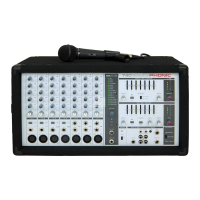

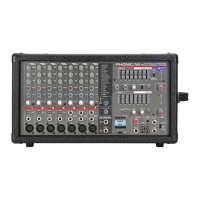
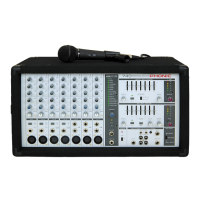
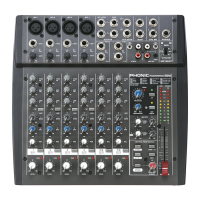
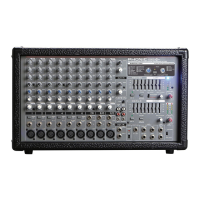

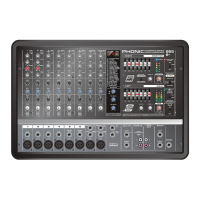
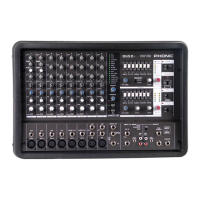
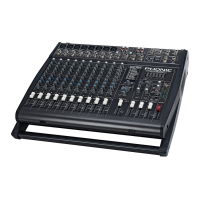
